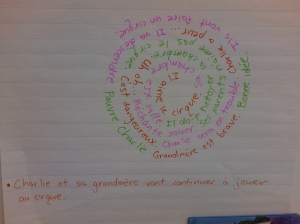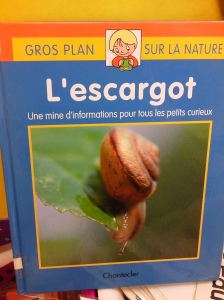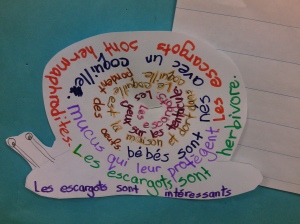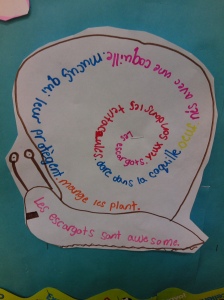I was so excited to go and work in the classroom of a former student! I felt a bit like Grandma Moses at first but the kids were great and it was really fun. Thanks to C.B. for inviting me in 🙂
If you can’t read French I think the ideas still apply.
Synthesizing is a difficult comprehension strategy for young students to name. They are able to do it quite naturally but the thinking process is not always apparent to them. In her book Reading with Meaning , Debbie Miller gave the following ideas for teaching to synthesizing:

In order to focus the students and give them a visual of what synthesizing might look like, we talked about how some things spiral and get bigger and bigger as we add to them. We had a brainstorming session of what kinds of things they might be. Some suggestions the children gave were cinnamon buns, noodles, screws, a snow ball as you roll it in the snow. As the children were making suggestions we would print the word on the board and draw a visual being sure to show how it could grow,. Some of their examples were better than others.
We started by reading a story together. Being read to Daily is essential for beginner readers to build vocabulary and fluency as well as comprehension. In French Immersion it is even more important that we read to children daily for them to develop the language. We read the story through once. Le Cirque Charlie Chou by Marie Louise Gay.
When we were done reading the story, the teacher and I reviewed our brainstormed list of things that “synthesize”. Then we talked about how when we listen to a story our thinking can change and grow. We read the story again but this time we wrote the student comments in the spiral form . We stopped every few pages for a new thought which was added in a new colour.
At the end of the story, the children had a spiral version of the story that added more and more information as we read. They discussed how their thinking about the story really had changed and grown as the story progressed and they added more information. We read another story to them (very slowly) and let them try to write their own spiral synthesis. The physical act was actually more difficult for some of them than the thinking was. We had many types of ” spiral” forms
Our next step was to talk about non-fiction reading. We said that when we learn about a topic, every time we read or view something new our thinking changes a little. One of the children pointed out that it was almost as if you can see the brain getting bigger-smarter as you learn more.
We read parts of two books about chimpanzees together.
We talked about the fact that it isn’t very easy to write in a spiral, and that an easier way to write out our thoughts is in a graphic organizer called a web.We modled putting some information into the graphic organizer. Then as a group decided what information we wanted to add to our understanding of chimpanzees.
We showed the children that we could then take that important information we had learned and put together –synthesized- into a paragraph. We created a class paragraph together. We talked about how we synthesized all the information we had learned from our chimpanzee Read alouds and that information helped us learn about chimpanzees and then write about them. As we used information in the large web, we checked it off.
Our next step was to choose another non-fiction text and see how the children were able to synthesize the information we were giving to them about snails.
We talked about the spiral writing and how that actually looked like a snail’s shell. They were very excited to try the spiral writing again. They knew that every new piece of information was to be written in a new colour. When we were done our snail read alouds, they would create their own synthesized snail writing. Here are a couple of samples and the class bulletin board.
This is only the beginning of synthesizing. Students need to start being aware of when their thinking changes and new thinking comes in. Kind of like when we delete and re-write when we are typing. Synthesizing takes a lot of practice. Using webs and other graphic organizers to help keep track of thinking is beneficial
It is really important for students to remember the key thinking:
We are changing our thinking !
I used to think…but now I think…
Related articles
- Synthesizing While Reading (teacherlingo.com)











May 3, 2013 at 1:47 pm
Thanks for giving us some visuals through the anchor charts and photos posted. It helped me to see synthesizing in action.
LikeLike